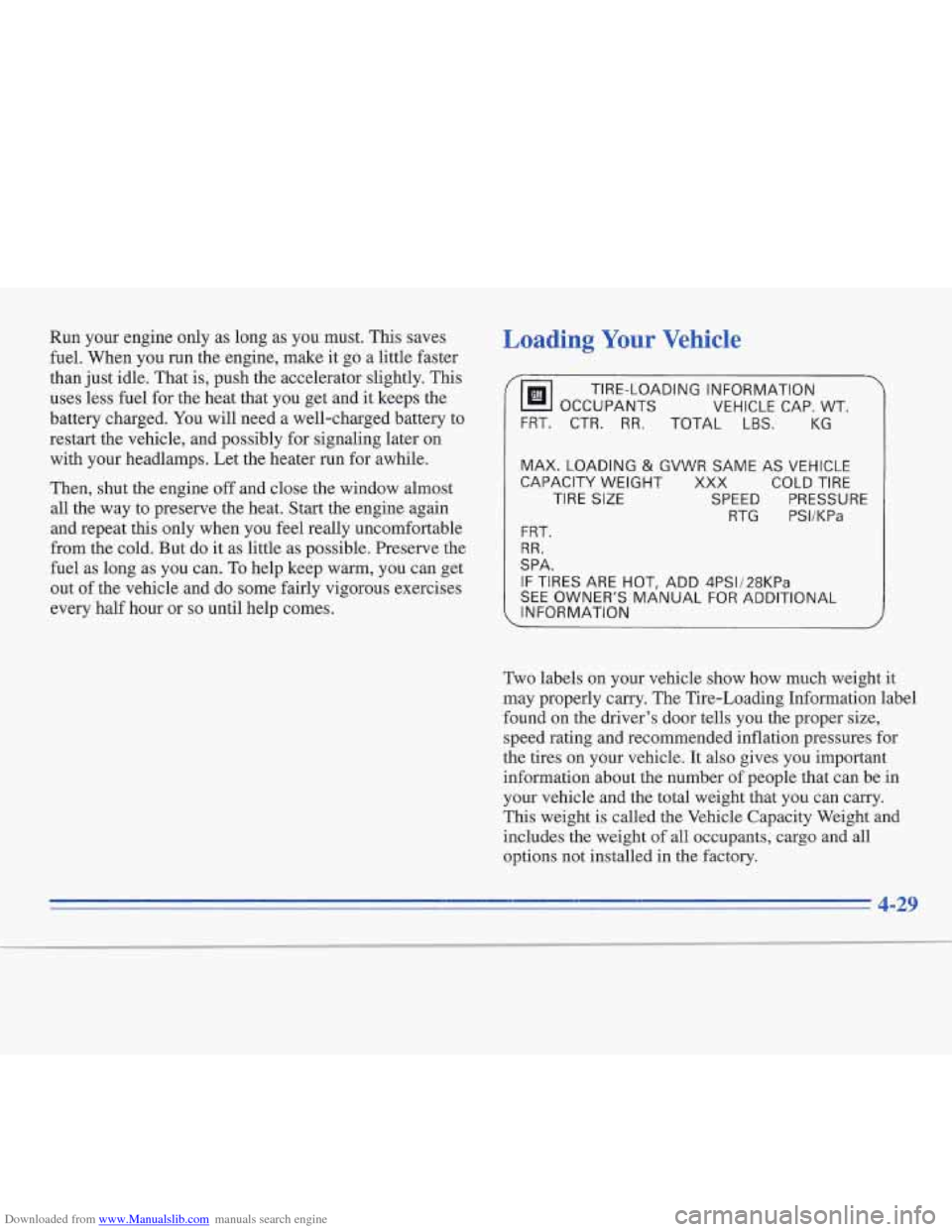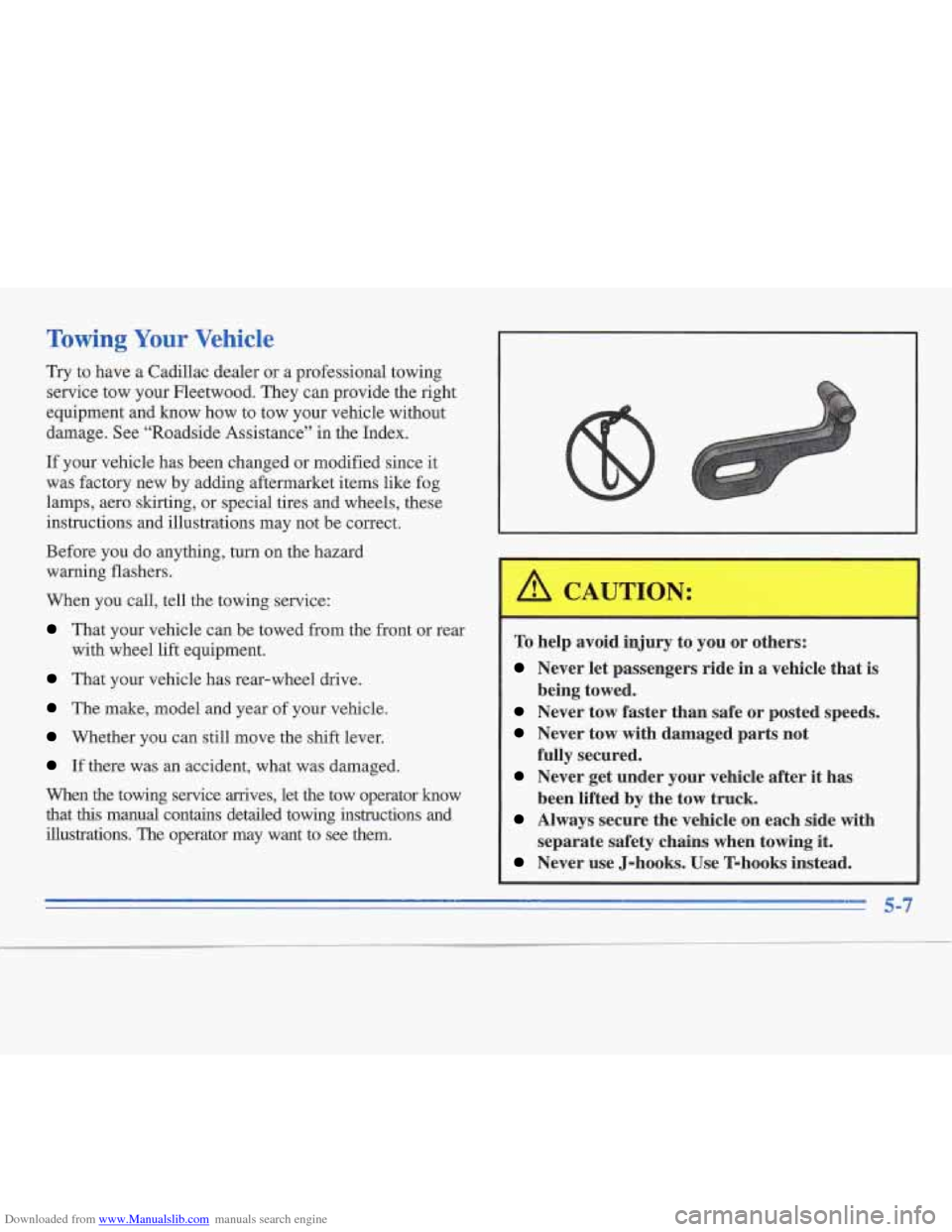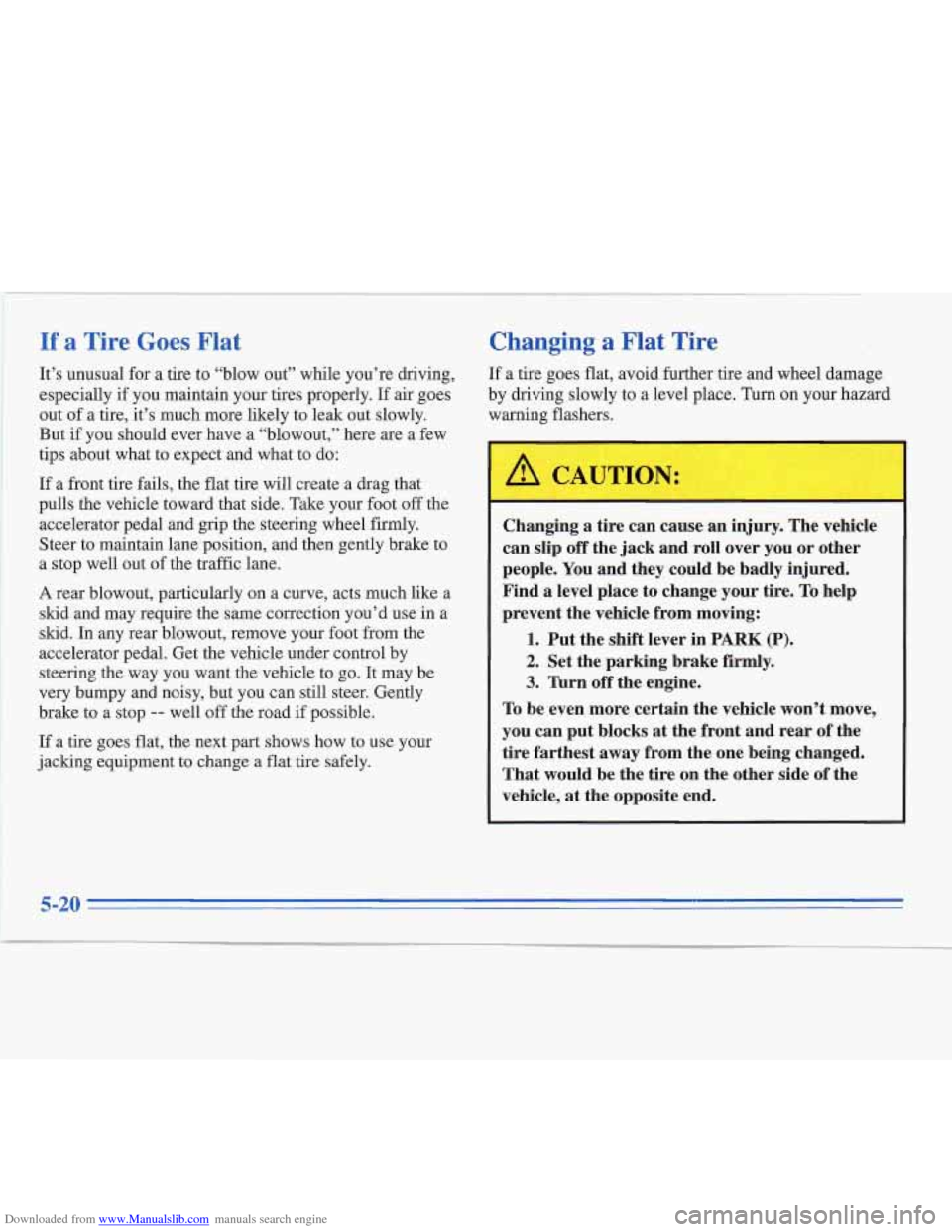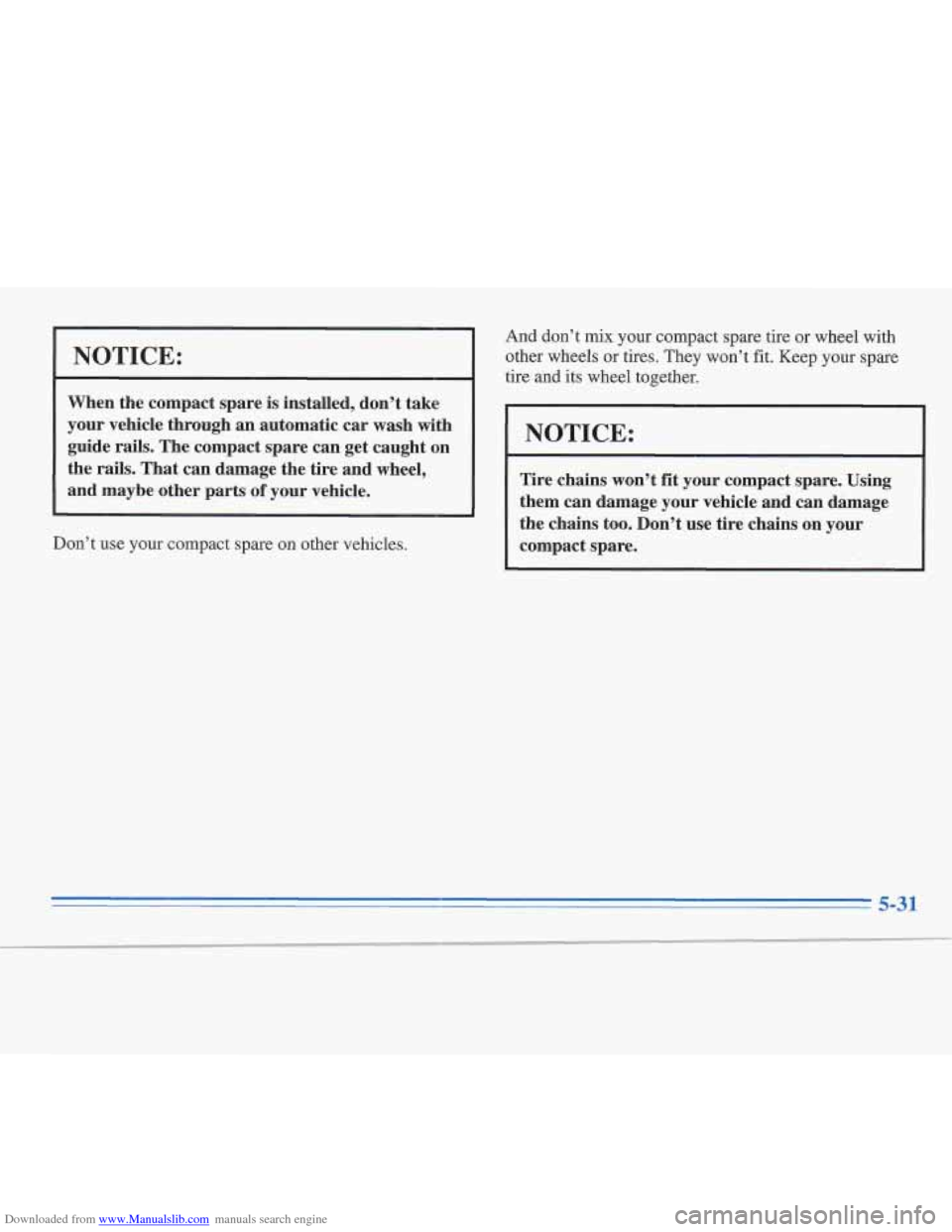1995 CADILLAC FLEETWOOD tires
[x] Cancel search: tiresPage 174 of 306

Downloaded from www.Manualslib.com manuals search engine Run your engine only as long as you must. This saves
fuel. When you run the engine, make it go a little faster
than just idle. That is, push the accelerator slightly. This
uses
less fuel for the heat that you get and it keeps the
battery charged. You will need a well-charged battery to
restart the vehicle, and possibly for signaling later on
with your headlamps. Let the heater
run for awhile.
Then, shut the engine
off and close the window almost
all the way to preserve the heat. Start the engine again
and repeat this only when you feel really uncomfortable
from the cold. But do it as little as possible. Preserve the
fuel as long as you can. To help keep warm, you can get
out of the vehicle and do some fairly vigorous exercises
every half hour or
so until help comes.
Loading Your Vehicle
Fm OCCUPANTS
VEHICLE CAP. WT.
TIRE-LOADING INFORMATION 7
FRT. CTR. RR. TOTAL LBS. KG
MAX. LOADING & GVWR SAME AS VEHICLE
CAPACITY WEIGHT
XXX COLD TIRE
TIRE SIZE SPEED PRESSURE RTG PSVKPa
FRT.
RR.
SPA.
IF TIRES ARE HOT, ADD 4PS1/28KPa
SEE OWNER'S MANUAL FOR ADDITIONAL
INFORMATION
Two labels on your vehicle show how much weight it
may properly carry. The Tire-Loading Information label
found on the driver's door tells you the proper size,
speed rating and recommended inflation pressures
for
the tires on your vehicle. It also gives you important
information about the number
of people that can be in
your vehicle and the total weight that you can carry.
This weight is called the Vehicle Capacity Weight and
includes the weight of all occupants, cargo and all
options not installed
in the factory.
4-29
Page 177 of 306

Downloaded from www.Manualslib.com manuals search engine Your vehicle can tow a trailer if it is equipped with
proper towing equipment. To identify what the vehicle
trailering capacity is for your vehicle, you should read
the information in “Weight of the Trailer” that appears
later in this section. But trailering is different than just
driving your vehicle by itself. Trailering means changes
in handling, durability, and fuel economy. Successful,
safe trailering takes correct equipment, and it has to be
used properly.
That’s the reason for this part. In it
are many
time-tested, important trailering tips and safety rules.
Many of these are important for your safety and that of
your passengers.
So please read this section carefully
before you pull a trailer.
Your Cadillac is a passenger vehicle. Trailer towing can
change the way your vehicle performs on the road. The
loads and forces created when trailering subject the
vehicle to significant levels of stress.
Load-pulling components such as the engine, transmission, rear axle, wheel assemblies and tires are
forced to work harder against the drag
of the added
weight. The engine is required to operate at relatively
higher speeds and under greater loads, generating extra
heat. What’s more, the trailer adds considerably to wind
resistance, increasing the pulling requirements.
If You Do Decide To Pull A Trailer
If you do, here are some important points:
0
0
e
0
0
There are many different laws, including speed limit
restrictions, having to do with trailering. Make sure
your rig will be legal, not only where you live but
also where you’ll be driving.
A good source for this
information can be state
or provincial police.
You should always use a weight distributing
(equalizing) hitch if your trailer will weigh more
than 3,000 lbs. (1 362 kg). Consider using sway
control if your loaded trailer will weigh 3,000 lbs.
(1 362 kg) or more. You can ask a hitch dealer
about sway controls.
Consider using a sway control if your trailer will
weigh 2,000 lbs.
(900 kg) or less. You should always
use a sway control if your trailer will weigh more
than
2,000 lbs. (900 kg). You can ask a hitch dealer
about sway controls.
Trailers that weigh more than
1,000 lbs. (454 kg)
should be equipped with trailer brakes.
Surge brakes may be used on some trailers (e.g., boat
trailers). However, surge brakes do not work well with most sway control devices.
Do not use sway
control devices on trailers equipped with surge brakes.
4-32
Page 178 of 306

Downloaded from www.Manualslib.com manuals search engine 0
0
0
0
Don’t tow a trailer at all during the first 1,000 miles
(1
600 km) your new vehicle is driven. Your engine,
axle or other parts could be damaged.
Then, during the first
500 miles (800 km) that you
tow a trailer, don’t drive over
50 mph (80 km/h) and
don’t make starts at full throttle. This helps your
engine and other parts
of your vehicle wear in at the
heavier loads.
Obey speed limit restrictions when towing a trailer.
Don’t drive faster than the maximum posted speed
for trailers (or no more than
55 mph (90 km/h))
to save wear on your vehicle’s parts. Avoid
continuous operation in mountainous areas that
have grades greater than two percent for longer than
5 miles (8 km).
Change axle lubricant annually or every 7,500 miles
(12
500 km) of trailer towing, whichever occurs first.
Three important considerations have to do with weight:
0 the weight of the trailer,
0 the weight of the trailer tongue
and the total weight on your vehicle’s tires.
Weight of the Trailer
How heavy can a trailer safely be?
It should never weigh more than 2,000 lbs.
(900 kg)
including the load or 7,000 lbs. (3 180 kg) if you have
the optional trailer towing package. But even that can be
too heavy.
It also depends on how you plan to use your rig.
For example, speed, altitude, road grades, outside
temperature and how much your vehicle is used
to pull a
trailer are all important. And, it can also depend
on any
special equipment that
you have on your vehicle,
You can ask your dealer for our trailering information or
advice, or you can write us at:
Consumer Relations Center
Cadillac Motor Car Division
30009 Van Dyke
P.O. Box 9025
Warren, MI 48090-9025
In Canada, write to:
General Motors of Canada Limited
Customer Assistance Center 1908 Colonel Sam Drive
Oshawa, Ontario L1
H 8P7
4-33
Page 179 of 306

Downloaded from www.Manualslib.com manuals search engine Weight of the Trailer Tongue
The tongue load (A) of any trailer is an important
weight to measure because it affects the total capacity
weight of your vehicle.
The capacity weight includes the
curb weight of the vehicle, any cargo you may carry in
it, and the people who will be riding in the vehicle. And
if you will tow a trailer, you must subtract the tongue
load from your vehicle’s capacity weight because your
vehicle will be carrying that weight, too. See “Loading
Your Vehicle” in the Index for more information about
your vehicle’s maximum load capacity.
B A
If you’re using a weight-carrying hitch, the trailer
tongue
(A) should weigh 10% of the total loaded trailer
weight
(B). If you have a “weight-distributing” hitch,
the trailer tongue
(A) should weigh 12% of the total
loaded trailer weight
(B).
After you’ve loaded your trailer, weigh the trailer and
then the tongue, separately, to see if the weights
are
proper. If they aren’t, you may be able to get them right
simply by moving some items around in the trailer.
Total Weight on Your Vehicle’s Tires
Be sure your vehicle’s tires are inflated to the
recommended pressure for cold tires. You’ll find these numbers on the Certification label at the
rear edge of the
driver’s door or
see “Loading Your Vehicle” in the Index.
Then be sure you don’t go over
the GVW limit for your
vehicle, including the weight
of the trailer tongue.
The Gross Combined Vehicle Weight (GCVW)
= curb
weight
+ passengers’ weight + cargo + trailer weight.
It should never exceed 7,450 lbs.
(3 1 SO kg) for the
standard vehicle
or 12,100 lbs. (5 490 kg) for the
7,000 lb. towing package.
4-34
Page 180 of 306

Downloaded from www.Manualslib.com manuals search engine Hitches
It’s important to have the correct hitch equipment.
Crosswinds, large trucks going by and rough roads are a
few reasons why you’ll need the right hitch. Here
are
some rules to follow:
e
e
e
If you’ll be pulling a trailer that, when loaded, will
weigh more than 2,000 lbs.
(900 kg), be sure to use a
properly mounted, weight-distributing hitch and
sway control of the proper size. This equipment
is
very important for proper vehicle loading and good
handling when you’re dnving.
Will you have to make any holes in the body of your
vehicle when you install a trailer hitch? If you do,
then be sure to seal the holes later when you remove
the hitch. If you don’t seal them, deadly carbon
monoxide (CO) from your exhaust can get into your
vehicle (see “Carbon Monoxide” in the Index). Dirt
and water can, too.
Don’t
let the steel in a hitch contact the aluminum on
your bumper. If you do, the two will corrode. You
can use something like paint or plastic tape to
separate the steel and aluminum. The same steel to
aluminum problem can happen with fasteners, too.
Using A Weight-Carrying Trailer Hitch
(Recommended for loaded trailers weighing less than
3,000 lbs. or
1 362 kg.)
The trailer tongue should weigh 10 percent of the
total trailer load (maximum 300 lbs. or 136 kg) or as
specified by the trailer manufacturer to minimize
sway.
Trailers that weigh more than 1,000 lbs. (454 kg)
should be equipped with trailer brakes.
Consider using sway control if your loaded trailer
will weigh 3,000 lbs.
(1 362 kg) or more.
Trailer Hitching Procedure Using A Weight
Distributing (Equalizing) Hitch
(Recommended for loaded trailers weighing 3,000 lbs.
to
7,000 lbs. or 1 362 kg to 3 178 kg.)
Using a weight distributing hitch without disabling the
Electronic Level Control (ELC) system may defeat the
purpose
of the weight distributing hitch. Also, your rear
tires may become overloaded. A weight distributing
hitch should spread the load to all axles. If you use a
weight distributing hitch, always disable the ELC by
following the proper steps.
4-35
Page 192 of 306

Downloaded from www.Manualslib.com manuals search engine Towing Your Vehicle
Try to have a Cadillac dealer or a professional towing
service tow your Fleetwood. They can provide the right
equipment and know how to tow your vehicle without
damage. See “Roadside Assistance” in the Index.
If your vehicle has been changed or modified since it
was factory new
by adding aftermarket items like fog
lamps, aero skirting, or special tires and wheels, these
instructions and illustrations may not be correct.
Before you do anything, turn on the hazard
warning flashers.
When you call, tell the towing service:
That your vehicle can be towed from the front or rear
with wheel lift equipment.
That your vehicle has rear-wheel drive.
The make, model and year of your vehicle.
Whether you can still move the shift lever.
If there was an accident, what was damaged.
When
the towing service arrives, let the tow operator know
that
this manual contains detailed towing instructions and
illustrations. The operator may want to see them.
To help avoid injury to you or others:
Never let passengers ride in a vehicle that is
Never tow faster than safe or posted speeds.
Never tow with damaged parts not
fuIly secured.
Never get under your vehicle after it has
been lifted by the tow truck.
Always secure the vehicle on each side with
separate safety chains when towing it.
Never use J-hooks. Use T-hooks instead.
being towed.
- 5-7
Page 205 of 306

Downloaded from www.Manualslib.com manuals search engine If a Tire Goes Flat
It’s unusual for a tire to “blow out” while you’re driving,
especially if you maintain your tires properly. If air goes
out of a
tire, it’s much more likely to leak out slowly.
But if you should ever have a “blowout,” here are
a few
tips about what to expect and what to do:
If a front tire fails, the flat tire will create a drag that
pulls the vehicle toward that side. Take your foot
off the
accelerator pedal and grip the steering wheel firmly.
Steer to maintain lane position, and then gently brake to
a stop well out of the traffic lane.
A rear blowout, particularly on a curve, acts much like a
skid and may require the same correction you’d use in a
skid.
In any rear blowout, remove your foot from the
accelerator pedal. Get the vehicle under control by
steering the way you want the vehicle
to go. It may be
very bumpy and noisy, but you can still steer. Gently
brake to a stop
-- well off the road if possible.
If a tire goes flat, the next part shows how to use your
jacking equipment to change a flat tire safely.
Changing a Flat Tire
If a tire goes flat, avoid further tire and wheel damage
by driving slowly to
a level place. Turn on your hazard
warning flashers.
I
Changing a tire can cause an injury. The vehicle
can slip off the jack and roll over you or other
people. You and they could be badly injured.
Find a level place to change your tire. To help
prevent the vehicle from moving:
1. Put the shift lever in PARK (P).
2. Set the parking brake firmly.
3. Turn off the engine.
To be even more certain the vehicle won’t move,
you can put blocks at the front and rear of the
tire farthest away from the one being changed.
That would be the tire on the other side
of the
vehicle,
at the opposite end.
5-20
Page 216 of 306

Downloaded from www.Manualslib.com manuals search engine NOTICE:
When the compact spare is installed, don’t take
your vehicle through
an automatic car wash with
guide rails. The compact spare can get caught on
the rails. That can damage the tire and wheel,
and maybe other parts
of your vehicle.
Don’t use your compact spare on other vehicles.
And don’t mix your compact spare tire or wheel with
other wheels or tires. They won’t fit. Keep your spare
tire and its wheel together.
I NOTICE:
Tire chains won’t fit your compact spare. Using
them can damage your vehicle
and can damage
the chains too. Don’t use tire chains on your
compact spare.
5-31